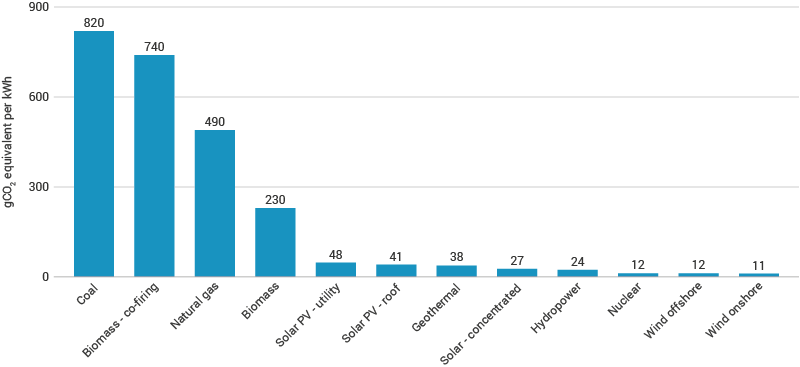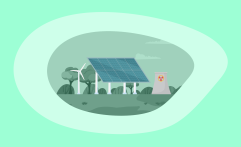Renewable Energy Credits (RECs): All 6 Pros and 4 Cons Explained
Impactful Ninja is reader-supported. When you buy through links on our site, we may earn an affiliate commission.
Learn more
Learn more
.
Hey fellow impactful ninja ? You may have noticed that Impactful Ninja is all about providing helpful information to make a positive impact on the world and society. And that we love to link back to where we found all the information for each of our posts. Most of these links are informational-based for you to check out their primary sources with one click. But some of these links are so-called "affiliate links" to products that we recommend. First and foremost, because we believe that they add value to you. For example, when we wrote a post about the environmental impact of long showers, we came across an EPA recommendation to use WaterSense showerheads. So we linked to where you can find them. Or, for many of our posts, we also link to our favorite books on that topic so that you can get a much more holistic overview than one single blog post could provide. And when there is an affiliate program for these products, we sign up for it. For example, as Amazon Associates, we earn from qualifying purchases. First, and most importantly, we still only recommend products that we believe add value for you. When you buy something through one of our affiliate links, we may earn a small commission - but at no additional costs to you. And when you buy something through a link that is not an affiliate link, we won’t receive any commission but we’ll still be happy to have helped you. When we find products that we believe add value to you and the seller has an affiliate program, we sign up for it. When you buy something through one of our affiliate links, we may earn a small commission (at no extra costs to you). And at this point in time, all money is reinvested in sharing the most helpful content with you. This includes all operating costs for running this site and the content creation itself. You may have noticed by the way Impactful Ninja is operated that money is not the driving factor behind it. It is a passion project of mine and I love to share helpful information with you to make a positive impact on the world and society. However, it's a project in that I invest a lot of time and also quite some money. Eventually, my dream is to one day turn this passion project into my full-time job and provide even more helpful information. But that's still a long time to go. Stay impactful,Affiliate Disclosure
Why do we add these product links?
What do these affiliate links mean for you?
What do these affiliate links mean for us?
What does this mean for me personally?
![]()
Renewable Energy Credits (RECs) foster the switch away from fossil fuels and towards renewable energy, which could lead to fewer carbon emissions and a healthier planet for future generations. So, we had to ask: What are the pros and cons of RECs?
Renewable Energy Credits (RECs) bolster the renewable energy market and are a cost-effective, environmentally friendly, decentralized method of carbon reduction. However, RECs can lack additionality, do not guarantee carbon avoidance, and occupy an oversaturated market.
Keep reading to find out all about what the pros and cons of Renewable Energy Credits (RECs) are, how you can offset your carbon footprint with RECs, how RECs can mitigate climate change, and what better alternatives to RECs are.
The Big Picture of Renewable Energy Credits (RECs)
Renewable Energy Credits (RECs) are a specific type of Energy Attribute Certificate (EAC), physical documentation that proves 1 megawatt-hour (MWh) of renewable energy has been added to the energy grid. EACs go by different names in different regions of the world. RECs simply refer to EACs in North American markets.
“REC: a market-based instrument that represents the property rights to the environmental, social, and other non-power attributes of renewable electricity generation”
United States Environmental Protection Agency
RECs are the currency of the renewable energy market in North America, representing the attributes of renewable energy that are generated and delivered to our power grid. They are measured in megawatt hours (MWh) of renewable electricity and target scope 2 emissions, or the emissions associated with purchased electricity.
RECs can come in two forms:
- Bundled: The REC is sold together with the energy associated with it.
- Unbundled: The REC has been separated from the physical electricity it represents.
RECs act as an accounting or tracking mechanism for renewable energies as they are incorporated into our power grid. Because we cannot distinguish energy generated from renewables and that produced by other sources, some form of tracking is required. To prevent someone else from claiming it, each REC can be uniquely numbered, tracked, and retired in the tracking system.
| 6 Pros of Renewable Energy Credits (RECs) | 4 Cons of Renewable Energy Credits (RECs) |
| RECs reduce your own carbon emissions | RECs often lack additionality |
| RECs bolster the renewable energy market | RECs do not guarantee carbon avoidance |
| RECs are cost-effective | RECs occupy an oversaturated market |
| RECs promote the decentralization of our energy supply | RECs may have intermittent energy production problems associated with renewable energy |
| RECs are a low-maintenance method of carbon emission reduction | |
| RECs are environmentally-friendly |
RECs aim to increase the share of renewable energy in our overall energy mix while decreasing the demand for fossil fuels. There are pros and cons to this methodology that must be understood in order to implement it effectively.
What Are 6 Pros of Renewable Energy Credits (RECs)
Renewable energy credits (RECs) reduce your own carbon emissions, bolster the renewable energy market, are cost-effective, promote the decentralization of our energy supply, are a low-maintenance form of carbon emission reduction, and are environmentally-friendly.
Pro #1: Renewable Energy Credits Reduce Your Own Carbon Emissions
RECs source their energy from renewables, which have a lower carbon footprint than fossil fuels, so your carbon footprint decreases as you use RECs.
Renewable Energy Credit Pro #1
RECs generate environmental benefits because the energy is produced without the burning of fossil fuels, which leads to a lower overall carbon footprint. When you purchase a REC, you source your energy from renewable resources rather than from fossil fuels. Since renewables have a lower carbon footprint than fossil fuels, your carbon footprint decreases as you use RECs.
On a life-cycle basis, the carbon footprint of renewable energy ranges anywhere from 11 (onshore wind) to 740 (biomass) grams of CO2 equivalent per kWh (gCO2/KWh) of electricity produced.

This is significantly lower than the 970, 820, and 490 gCO2/KWh emitted by oil, coal, and natural gas, respectively.
In short, RECs have a lower carbon footprint than fossil fuels, so purchasing them also lowers your carbon footprint.
Pro #2: Renewable Energy Credits Bolster the Renewable Energy Market
RECs bolster the renewable energy market and reduce the demand for fossil fuels.
Renewable Energy Credit Pro #2
The goal of RECs is to reduce carbon emissions to mitigate climate change while promoting the creation of new, renewable energy. RECs represent the creation of new renewable energy to be supplied to our power grid. They can reduce the demand for “dirty”, fossil-fueled energies and increase the demand for renewable energies, bolstering the market.
In short, RECs increase the demand for renewable energy which in turn bolsters the renewable energy market.
Pro #3: Renewable Energy Credits are Cost-Effective
RECs are cost-effective compared to other methods of carbon reduction.
Renewable Energy Credit Pro #3
Historically, RECs have been a cost-effective way of reducing carbon emissions. Green-e®, the governing body that tracks and retires certified RECs in North American markets, saw a price jump from $0.50 to $8 per REC in recent years. But this is still cheaper than direct carbon capture offsets which can cost anywhere from $250-$650 per ton and reforestation efforts which cost approximately $50 per ton.
In addition, the European equivalent of RECs, European Guarantee of Origin certificates, cost a mere €0.85 per MWh in 2020. This is significantly less than the €40 per MWh wholesale price tag for the underlying electricity itself.
In short, RECs are a relatively cost-effective method of carbon emission reduction.
Pro #4: Renewable Energy Credits Promote Decentralization of Our Energy Supply
RECs promote decentralization of our energy supply which reduces peak time usage and decreases the likelihood of power outages.
Renewable Energy Credit Pro #4
The traditional grid works something like this:
- Power plants generate electricity
- Transformers step up voltage for transmission
- Transmission lines transport electricity over long distances
- Neighborhood transformer steps down voltage
- Transformers on poles step down electricity before it enters homes
This worked fine in the past when energy demand was much lower, but globally our electricity usage is steadily increasing, and renewable energy makes up an increasingly bigger share of our total energy consumption.
RECs draw renewable energy from various geographic locations, so the grid can distribute power from multiple plants. This decentralization in turn reduces peak time usage and decreases the likelihood of power outages.
In short, RECs promote decentralization of our energy supply because renewable energy can be sourced from various geographical locations.
Pro #5: Renewable Energy Credits are a Low-Maintenance Form of Carbon Emission Reduction
RECs are a low-maintenance form of carbon emission reduction because they do not require the purchaser to build any renewable energy infrastructure.
Renewable Energy Credit Pro #5
RECs are certified proof that you are using renewable energy without you having to install the required infrastructure. For example, with RECs, you are able to claim your energy comes from solar power without having to install solar panels on your property. Solar panels can cost anywhere from $15-25,000 to install, and they require routine cleaning to ensure optimal performance.
With RECs, the purchaser does not have to maintain any renewable energy infrastructure, making them a low-maintenance form of carbon emission reduction that can incentivize the switch to renewables even more.
In short, RECs are a low-maintenance form of carbon emission reduction because the purchaser does not have to install or maintain renewable energy infrastructure.
Pro #6: Renewable Energy Credits are Environmentally-Friendly
RECs share the environmental benefits associated with renewable energy, which goes beyond simply reducing carbon emissions.
Renewable Energy Credit Pro #6
Six of the seven main types of renewable energy come with their own set of environmental benefits:
- Solar: Throughout its life cycle, concentrated solar energy produces 0.04%, PV roof solar energy produces 0.05%, and PV utility solar energy produces 0.06% of the CO2 emissions per unit of electricity than coal produces.
- Wind: Throughout its life cycle, wind energy produces 0.02% of the CO2 emissions per unit of electricity than coal produces. And after 3 to 6 months of operation, a wind turbine has effectively offset all emissions from its construction, which means it can operate virtually carbon-free for the rest of its lifetime.
- Hydropower: Hydropower has the potential to reduce overall GHG emissions by 5.6 gigatons by 2050, which is equivalent to nearly 1.2 billion passenger vehicles driven in a year. This would also save around $209 billion in damages caused by climate change.
- Geothermal: Throughout its life cycle, geothermal energy produces 5% of the CO2 emissions per unit of electricity that coal produces. In the US alone, annual geothermal energy resources effectively offset the emission of 4.1 million metric tons (t) of carbon.
- Tidal and wave: Tidal energy produces 0.03% of the CO2 emissions per unit of electricity that coal produces, and wave energy also produces low levels of emissions. Tidal and wave energy could help reduce global CO2 emissions from fossil fuel electricity generation by around 500 million tons by the year 2050.
Biomass is the only renewable energy that is not as environmentally friendly as it appears at first glance. Existing biomass power plants can emit more CO2 from their smokestacks than coal plants, and chopping trees to produce wood pellets that are burned for electricity speeds up deforestation and reduces the number of trees that can capture our CO2 emissions (decreases carbon sequestration).
In short, RECs are sourced from renewable energy sources which each come with their own set of environmental benefits.
What Are 4 Cons of Renewable Energy Credits (RECs)
Renewable Energy Credits (RECs) often lack additionality, do not guarantee carbon avoidance, occupy an oversaturated market, and may have intermittent energy production problems associated with renewable energy.
Con #1: Renewable Energy Credits Often Lack Additionality
RECs often lack additionality because most projects receiving REC revenue now would have been built regardless.
Renewable Energy Credit Con #1
To be beneficial, RECs must be additional. This means the carbon emissions reductions would not have occurred without REC interventions.
But RECs are often not additional because most projects receiving REC revenue now would have been built regardless. Driven by decreasing costs and improved technology, renewable energy capacity grew 3.7-fold from 2000-2020, increasing from 754 gigawatts (GW) to 2,799 GW. The large demand for renewable energy in general means that the infrastructure would have been built independently of RECs.
In short, additionality is not guaranteed with RECs because renewable energy projects are already in high demand and would have been built regardless.
Con #2: Renewable Energy Credits Do Not Guarantee Carbon Avoidance
RECs do not curtail energy from fossil fuels or limit their production.
Renewable Energy Credit Con #2
RECs bolster the renewable energy market and increase renewable energy supply to the power grid, but they do not curtail energy from fossil fuels or limit their production. RECs allow purchasers to write off their carbon emissions without requiring them to reduce their current emissions.
In short, we should think of purchasing RECs as supporting renewable energy rather than curtailing fossil fuels.
Con #3: Renewable Energy Credits Occupy An Oversaturated Market
Low REC prices and the thundering success of the renewable energy market have led to market oversaturation.
Renewable Energy Credit Con #3
One main problem with RECs is that the market is oversaturated due to the thundering success of the renewable energy market, and RECs are now so cheap to buy that they are not a big enough revenue source to make a difference on a large power project.
The global REC market was valued at $9.3 billion in 2020 and is expected to exceed $100 billion by 2030. The market is being driven by rooftop solar panels, micro wind turbines, and micro hydropower plants.
Unbundled RECs have also seen rapid growth in the past decade, increasing from 19.8 million MWh in 2010 to 86.4 million MWh in 2020, and they are now the most common form of green-power procurement in the voluntary market.
In short, rapid renewable energy growth and low REC prices have resulted in an oversaturated REC market.
Con #4: Renewable Energy Credits May Have Intermittent Energy Production Problems Associated With Renewable Energy
RECs are sourced from renewable energy and therefore share some potential intermittent energy production problems associated with it.
Renewable Energy Credit Con #4
Because RECs are sourced from renewable energy, they also share some of the same drawbacks as renewable energy. These include intermittent energy production, geographic limitations, and lower quantities of energy being produced.
Different renewable energy sources are abundant in different regions of the world, and some are only generated at certain times of the day. For example, solar energy can only be produced when the sun is shining, geothermal energy requires siting of power plants where thermal reservoirs are located, and wind energy can only be produced when winds reach a certain speed.
In short, RECs share some of the potential intermittent energy production problems associated with renewable energy in general.
How Could you Offset Your Own Carbon Footprint With Renewable Energy Credits (RECs)
Unbundled RECs have seen rapid growth in the past decade, increasing from 19.8 million MWh in 2010 to 86.4 million MWh in 2020, and they are now the most common form of green-power procurement in the voluntary market.
Because RECs are cost-effective and directly reduce your own carbon emissions, they are predicted to make up an increasingly larger share of this market.
| Renewable Energy Credit (REC) Company | Quick Facts |
| Terrapass | Terrapass offers RECs that support renewable energy projects such as wind and solar farms. |
| South Pole | South Pole offers RECs that support renewable energy projects including geothermal, small hydropower, and solar. |
| ClimeCo | ClimeCo’s RECs are sourced from a variety of renewable energy resources and can be purchased on a commercial or wholesale basis anywhere in the US. |
| 3Degrees | 3Degrees offers RECs that support renewable energy projects including solar projects in Uganda, Kentucky, and Massachusetts. |
| Native Energy | Native Energy offers RECs that support wind, solar, wind/ solar hybrids, landfill gas, small-scale hydro, and biomass renewable energy projects across the US. |
| Act Commodities | Act offers Renewable Energy Quota Certificates (REQCs) for purchase on the mandatory market and Energy Attribute Certificates (EACs), which includes RECs, for purchase on the voluntary market. |
| Bonneville Environmental Foundation | Bonneville Environmental Foundation offers RECs that support wind and solar renewable energy projects. They also offer stacked RECs. |
| Anew Environmental | Anew Environmental offers RECs that support renewable energy projects such as wind and solar farms. |
| GO2 Markets | GO2 Markets offers wind, solar, biomass, hydro, thermal, and geothermal RECs dependent on the geographic location of your energy consumption. |
How Can Renewable Energy Credits (RECs) Help Mitigate Climate Change
Climate change is a severe and long-term consequence of fossil fuel combustion. Renewable Energy Credits (RECs) can help mitigate climate change because they increase the market for renewable energy and incentivize the switch away from traditional fossil fuels, which emit billions of tons of carbon every year. Atmospheric carbon can remain in circulation for tens of thousands of years and exacerbate the negative effects of climate change.
How is Climate Change Defined
Climate change is arguably the most severe, long-term global impact of fossil fuel combustion. Every year, approximately 33 billion tons (bt) of CO2 are emitted from burning fossil fuels. The carbon found in fossil fuels reacts with oxygen in the air to produce CO2.
“Climate change: changes in the earth’s weather, including changes in temperature, wind patterns and rainfall, especially the increase in the temperature of the earth’s atmosphere that is caused by the increase of particular gasses, especially carbon dioxide.”
Oxford Dictionary
Atmospheric CO2 fuels climate change, which results in global warming. When CO2 and other air pollutants absorb sunlight and solar radiation in the atmosphere, it traps the heat and acts as an insulator for the planet. Since the Industrial Revolution, Earth’s temperature has risen a little more than 1 degree Celsius (C), or 2 degrees Fahrenheit (F). Between 1880-1980 the global temperature rose by 0.07C every 10 years. This rate has more than doubled since 1981, with a current global annual temperature rise of 0.18C, or 0.32F, for every 10 years.
As outlined in the 2015 Paris Climate Agreement, we must cut current GHG emissions by 50% by 2030 and reach net zero by 2050.
How Do Renewable Energy Credits (RECs) Generally Help Mitigate Climate Change
Levels of carbon in our atmosphere that cause climate change have increased as a result of human emissions since the beginning of the Industrial Revolution in 1750. The global average concentration of carbon dioxide in the atmosphere today registers at over 400 parts per million. RECs can help prevent these levels from increasing even more.
When you hear the word “REC”, think about the term “renewable energy”. RECs represent the creation of renewable energy to be supplied to our power grid. RECs can reduce the demand for “dirty”, fossil-fueled energies by bolstering the renewable energy market.
RECs that are certified by verified third parties and are a part of renewable energy projects that are carried out until the end of their lifespan have the best chance of reducing carbon emissions and therefore mitigating climate change.
When we reduce CO2 emissions we also slow the rate of global temperature rise, which in turn minimizes the effects of climate change.
How Do Renewable Energy Credits (RECs) Specifically Help Mitigate Climate Change
Renewable energy credits specifically help mitigate climate change because they bolster the renewable energy market, which reduces the demand for fossil fuels and subsequently reduces carbon emissions.
Renewable energy is important to meet Paris Climate Agreement targets because it reduces our dependence on fossil fuels, which produce carbon that can remain in our atmosphere for tens of thousands of years.
What Are Better Alternatives to Renewable Energy Credits (RECs)
If used correctly, renewable energy credits (RECs) can provide environmental, economic, and social benefits beyond reducing carbon emissions. They have the potential to instigate meaningful environmental change and begin to reverse some of the effects of climate change.
However, we can’t let this method be a guilt-free way to reduce carbon emissions. Relying on RECs solely is impractical because they are so cheap that they have become irrelevant to the financing and investment decisions of the power industry. Instead, RECs must be used in conjunction with direct carbon reduction measures.
These reduction measures don’t have to involve drastic changes either. Actions that may seem small can have a big impact because those small changes add up! You can reduce your carbon footprint in three main areas of your life: household, travel, and lifestyle.
Reduce your household carbon footprint:
- Wash with cold water: Washing clothes in cold water could reduce carbon emissions by up to 11 million tons. Approximately 90% of the energy is used to heat the water, so switching to cold saves also saves energy.
- Replace incandescent bulbs with fluorescent bulbs: Fluorescent bulbs use 75% less energy than incandescent ones, saving energy and thus reducing electricity demand and GHG emissions.
Reduce your travel carbon footprint:
- Fly less: Aviation accounts for around 1.9% of global carbon emissions and 2.5% of CO2. Air crafts run on jet gasoline, which is converted to CO2 when burned.
- Walk or bike when possible: The most efficient ways of traveling are walking, bicycling, or taking the train. Using a bike instead of a car can reduce carbon emissions by 75%. These forms of transportation also provide lower levels of air pollution.
Reduce your lifestyle carbon footprint:
- Switch to renewable energy sources: The six most common types of renewable energy are solar, wind, hydro, tidal, geothermal, and biomass energy. They are a substitute for fossil fuels that can reduce the effects of global warming by limiting global carbon emissions and other pollutants.
- Recycle: Recycling uses less energy and deposits less waste in landfills. Less manufacturing and transportation energy costs means fewer carbon emissions generated. Less waste in landfills means less CH4 is generated.
- Switch from single-use to sustainable products: Reusing products avoids resource extraction, reduces energy use, reduces waste generation, and can prevent littering.
- Eat less meat and dairy: Meat and dairy account for 14.5% of global GHG emissions, with beef and lamb being the most carbon-intensive. Globally, we consume much more meat than is considered sustainable, and switching to a vegan or vegetarian diet could reduce emissions.
- Take shorter showers: Approximately 1.2 trillion gallons of water are used each year in the United States just for showering purposes, and showering takes up about 17% of residential water usage. The amount of water consumed and the energy cost of that consumption are directly related. The less water we use the less energy we use. And the less energy we use, the less of a negative impact we have on the environment.
Because the market for RECs is oversaturated and they do not curtail fossil fuel production, RECs alone will not be enough to reduce global carbon emissions significantly. Reducing individual energy use and consumption are better alternatives to RECs.
Final Thoughts
Renewable energy credits (RECs) reduce your own carbon emissions, bolster the renewable energy market, are cost-effective, promote the decentralization of our energy supply, are a low-maintenance form of carbon emission reduction, and are environmentally-friendly. However, they often lack additionality, do not guarantee carbon avoidance, occupy an oversaturated market, and may have intermittent energy production problems associated with renewable energy.
For all of the good RECs can instigate, they should not be seen as the only solution to climate change. In the long term, they fail to reduce CO2 enough to mitigate climate change for future generations. When used in conjunction with direct CO2 reduction measures, RECs can be much more effective. We should reduce our own carbon footprint as much as possible first, and only then choose RECs.
Stay impactful,

Sources
- United States Environmental Protection Agency: Renewable Energy Certificates (RECs)
- 3Degrees: RECs and Other Global EACs
- United States Environmental Protection Agency: Scope 1 and Scope 2 Inventory Guidance
- United States Environmental Protection Agency: Guide to Purchasing Green Power
- United States Environmental Protection Agency: Unbundle Electricity and Renewable Energy Certificates
- Investopedia: Renewable Energy Certificate (REC)
- Impactful Ninja: What Are Renewable Energy Credits (RECs) and How Do They Work? The Big Picture
- Terrapass: How do RECs work?
- World Nuclear Association: Average life-cycle CO2 equivalent emissions
- Impactful Ninja: What Is the Carbon Footprint of Renewable Energy? A Life-Cycle Assessment
- Impactful Ninja: What Is the Carbon Footprint of Oil Energy? A Life-Cycle Assessment
- Impactful Ninja: What Is the Carbon Footprint of Coal Energy? A Life-Cycle Assessment
- Impactful Ninja: What Is the Carbon Footprint of Natural Gas Energy? A Life-Cycle Assessment
- World Nuclear Association: Carbon Dioxide Emissions From Electricity
- Usource: RECs are expensive. Now What? Alternative to Meeting Your Sustainability Metrics
- World Resources Institute: Direct Air Capture – 6 Things to Know
- S&P Global: European Guarantees of Origin assessments
- S&P Global: Problematic corporate purchases of clean energy credits threaten net zero goals
- U.S. Energy Information Administration: Electricity Explained – Delivery to Consumers
- U.S. Energy Information Administration: Electricity Explained – Use of Electricity
- Electrical Academia: Difference between Traditional Power Grid and Smart Grid
- Forbes: How Much Do Solar Panels Cost?
- Forbes: The Ultimate Solar Panel Maintenance Guide To Keep Your Panels Working As Efficiently As Possible
- Impactful Ninja: What Is the Carbon Footprint of Solar Energy? A Life-Cycle Assessment
- Impactful Ninja: What Is the Carbon Footprint of Wind Energy? A Life-Cycle Assessment
- The Global Wind Energy Council: Wind power is crucial for combating climate change
- Impactful Ninja: What Is the Carbon Footprint of Hydropower Energy? A Life-Cycle Assessment
- U.S. Department of Energy: Hydropower Vision – New Report Highlights Future Pathways for U.S. Hydropower
- Impactful Ninja: What Is the Carbon Footprint of Geothermal Energy? A Life-Cycle Assessment
- National Renewable Energy Laboratory: Buried Treasure – The Environmental, Economic, and Employment Benefits of Geothermal Energy
- Impactful Ninja: What Is the Carbon Footprint of Tidal and Wave Energy? A Life-Cycle Assessment
- Union of Concerned Scientists: Environmental Impacts of Hydrokinetic Energy
- U.S. Government Accountability Office: Science & Tech Spotlight – Renewable Ocean Energy
- Natural Resources Defense Council: How the Biomass Industry Sent “Sustainability” Up in Smoke
- Our World in Data: Deforestation and Forest Loss
- One Green Planet: How Saving Wildlife Benefits Humans – In Ways We Really Need
- Carbon Offset Guide: Additionality
- Vox: RECs, which put the “green” in green electricity, explained
- International Renewable Energy Agency: Renewable Power Generation Costs in 2020
- Allied Market Research: Renewable Energy Certificate Market Outlook 2021-2030
- The National Renewable Energy Laboratory: Voluntary Green Power Procurement
- Solar Schools: Advantages and Disadvantages
- The American Physical Society: Renewable Energy’s Intermittency is Not a Showstopper
- Terrapass: Homepage
- South Pole: Homepage
- ClimeCo: Homepage
- 3Degrees: Homepage
- Native Energy: Homepage
- Act Commodities: Homepage
- Bonneville Environmental Foundation: Homepage
- Anew Environmental: Homepage
- GO2 Markets: Homepage
- Impactful Ninja: Best Renewable Energy Credits (RECs)
- Natural Resources Defense Council: Global Warming 101
- United Nations Convention Framework on Climate Change: The Paris Agreement
- myclimate: What does “net zero emissions” mean?
- National Oceanic and Atmospheric Administration: Climate Change – Atmospheric Carbon Dioxide
- American University: Fact Sheet: Carbon Removal
- The Ocean Foundation: Reduce Your Carbon Footprint
- Energy Information Administration: Renewable Energy Explained
- Energy Star: Compact Fluorescent Light Bulbs (CFLs) and Mercury
- Our World in Data: Where in the world do people have the highest CO2 emissions from flying?
- Zero Waste Europe: Reusable vs Single Use Packaging
- Carbonbrief: Interactive – What is the climate impact of eating meat and dairy?
- Stop Waste: Recycling and Climate Protection
- Impactful Ninja: Is Taking Long Showers Bad for the Environment?
- United States Environmental Protection Agency: Showerheads
- Impactful Ninja: 4 Main Reasons Why Reducing Your Carbon Footprint is Important




